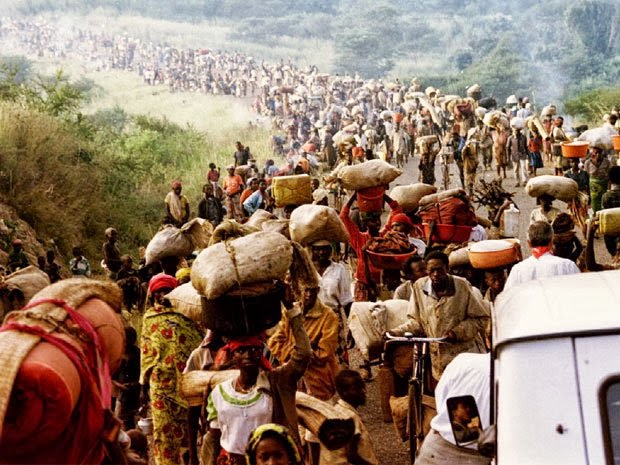Khmer Killing Fields
Wednesday, September 10, 2014
Thursday, August 7, 2014
Thursday, May 29, 2014
Reeducating Rwanda to change paradigm of origin of Tutsi as being form" Ethiopia became main cause of the genocide"
David Moshman Become a fanProfessor of Educational Psychology
Original title-
Education for Rwanda
What is education for?
Education is for learning, of course. But is it also for anything else?
Some advocate education for thinking, education for rationality or education for development. Some support education for liberty or education for democracy Some propose education for life or education for change.
No one advocates education for genocide. But schools sometimes serve that purpose.
In From Classrooms to Conflict in Rwanda (Cambridge University Press, 2014), Elisabeth King concludes that education played a major role in the societal trends leading to the 1994 Rwanda genocide and that Rwandan schools continue to play a major role in exacerbating social conflict. Her analysis is consistently thorough, insightful and convincing.
King discusses education in Rwanda during three successive historical periods: Belgian colonization (1919-1962), the post-colonial Republics (1962-1994) and the period since the 1994 genocide. Within each, she systematically addresses three interrelated issues: differential access to education, the presentation of Rwandan history and the treatment of identity.
King interviewed, and quotes extensively from, 80 individuals, most of whom had been teachers or students (or both) in Rwandan schools during one or more of the three historical periods. Most of the 75 Rwandans identified themselves as either Hutu or Tutsi. The other five interviewees were elderly Belgians, interviewed in Belgium, who had served as colonial administrators or missionaries.
King also interviewed Rwandan professors and government officials, spoke informally with many other Rwandans, and studied curriculum materials and educational policy documents. Her presentation is scholarly but she doesn't hesitate to reach conclusions justifiably critical of Rwandan educational policy and practice in all three historical periods.
Beginning with the Belgian colonial period, King notes that access to primary schools (grades 1-6) was extremely limited. Most primary students were Tutsi despite the fact that Tutsi were a minority (about 15 percent) of the population. Most students failed to complete grade 6 and only a tiny proportion -- overwhelmingly Tutsi -- went on to secondary education.
History education in colonial primary schools consisted mostly of European history. Secondary schools taught a European version of Rwandan history in which the Tutsi were a superior Caucasian race that came south centuries ago from Ethiopia and rightly dominated the Hutu, a backward Bantu race that had arrived previously and dominated the indigenous Twa.
Identity -- defined as Hutu, Tutsi, or Twa -- was highlighted throughout the secondary curriculum. The Twa, about one percent of the population, were marginalized and ignored. A typical text noted that the Hutu showed "atavistic stupidity" whereas the Tutsi, who were taller and had finer features, were "sage and prudent." The Tutsi, as one teacher put it, were "aristocratic Negroes."
And then everything changed, except what didn't.
With independence in the early 1960s the Hutu majority gained control for the first time, but the differentiation of Hutu from Tutsi intensified. Hutu access to schooling increased dramatically as Rwanda's education system expanded, but Tutsi access beyond the primary level was limited by strict quotas.
After independence, Rwandan history began to be taught in primary schools and received increased attention in secondary schools. Now the Tutsi were presented as immigrants who oppressed the Hutu cultivators already working the land. As one interviewee described the curriculum, "they said that Rwanda was for Hutu. They are Rwandan. The others, it is for them to stay in Ethiopia."
In many classes toward the end of this period, students were required to sort themselves as Hutu or Tutsi. Most knew their group; those who didn't learned where they belonged. Despite the dramatic reversal since colonial times in the status of the two groups, everyone still learned that one group was good and the other bad.
Looking across the colonial and post-colonial periods, there are deep and troubling continuities. In addition to ongoing problems of differential access to education, we see divisive social processes of mandatory categorization and systematic group stigmatization.
By the early 1990s, the division of Rwandans into Hutu and Tutsi categories was moving inexorably toward strictly dichotomized and collectivized identities. Each Rwandan was identified and understood first and foremost as Hutu or Tutsi. The associated stigmatization, meanwhile, was escalating into the radical dehumanization that makes genocide possible.
In spring 1994 the schools all closed as hundreds of thousands of Hutu killed hundreds of thousands of Tutsi. The rivers were clogged with the bodies of Tutsi on their way back, it was said, to Ethiopia.
In September 1994 schools began to reopen. In a future post, I will discuss King's account of Rwandan education since 1994 and her well-justified fears for the future.
Thursday, March 27, 2014
Saturday, March 1, 2014
Wednesday, January 1, 2014
Subscribe to:
Posts (Atom)
